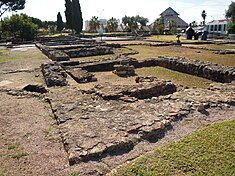Roman ruins of Cerro da Vila
| Roman Ruins of Cerro da Villa (Ruínas Romanas do Cerro da Vila) | |
| Cerro da Vila | |
| Ruins (Ruínas) | |
|
Vestiges of the walls of the dwellings and dependencies
|
|
| Name origin: cerro da vila Spanish for hill of the town | |
| Country | |
|---|---|
| Region | Algarve |
| Subregion | Algarve |
| District | Faro |
| Municipality | Loulé |
| Location | Quarteira |
| - elevation | 11 m (36 ft) |
| - coordinates | 37°4′47.81″N 8°7′13.82″W / 37.0799472°N 8.1205056°WCoordinates: 37°4′47.81″N 8°7′13.82″W / 37.0799472°N 8.1205056°W |
| Length | 106.97 m (351 ft), Southwest-Northeast |
| Width | 146.95 m (482 ft), Northwest-Southeast |
| Architects | unknown |
| Style | Roman |
| Materials | Limestone, Masonry |
| Origin | 27 B.C. |
| For public | Private |
| Visitation | Closed (Mondays, Tuesday mornings, every weekend of each month, and on 1 January, Easter Sunday, 1 May and 25 December) |
| Easiest access | Avenida Cerro da Vila, opposite Hotel da Marinha, Vilamoura |
| Management | Instituto Gestão do Patrimonio Arquitectónico e Arqueológico |
| Hours | 9:30 a.m.-12:30 p.m.; 2:00 p.m.-6:00 p.m. |
| Status | Property of Public Interest |
| Listing | Decree 129/77; DR226, 29 September 1977 |
The Roman Ruins of Cerro da Vila are the remnants of a historical villa in the Algarve region of southern Portugal. Its vestiges lie in the vicinity of the resort and marina of Vilamoura, in the civil parish of Quarteira, municipality of Loulé Municipality.
The area around Vilamoura, in which the remains of this Roman villa can be found, has been occupied with human activity for thousands of years. Graves dating back to the Bronze Age were discovered in the municipality in the Casão vineyard.
The Romans where the first to establish a settlement of any size within the locality; during the 2nd century, the region of the Algarve fell under the domain of Rome, under the rule of Gaius Julius Caesar Augustus (23 September 63 BC – 19 August AD 14). The region was integrated into the Province of Lusitania, in reorganized into three into three civitas: Balsa (Luz de Tavira), Ossonoba (Faro) and Ciuitas, whose capital was either Cilpes (Silves) or more probably at Lacobriga (Lagos). Cerro da Vila was situated in the Ossonoba territory and had a port, serving the fertile lands irrigated by a dam two kilometres from the settlement.
Following its construction, the villa was periodically occupied by Visigoths and Arab (Moorish) forces. A group of silos from the Moorish period, in the interior of the Roman houses, support continuous occupation after the Romans.
It was included in the Programa de Valorização e Divulgação Turística: Itinerários Arqueológicos do Alentejo e Algarve (Touristic Valorization Program) in 1999, by the Ministry of Commerce and Tourism, and the Secretary-of-State for Culture. Consequently, in 2000, an interpretive centre, under the supervision of architect Fernando Galhano was constructed to support tourism, to be operated by the IPPR (later the Instituto Gestão do Patrimonio Arquitectónico e Arqueológico-IGESPAR).
...
Wikipedia

